brake light TOYOTA LAND CRUISER 2013 J200 Owner's Manual
[x] Cancel search | Manufacturer: TOYOTA, Model Year: 2013, Model line: LAND CRUISER, Model: TOYOTA LAND CRUISER 2013 J200Pages: 720, PDF Size: 21.46 MB
Page 521 of 720

521 4-2. Maintenance
4
Maintenance and care
LC200_OM_OM60F57U_(U)
Vehicle interior
ItemsCheck points
Accelerator pedal• Moves smoothly (without uneven
pedal effort or catching)?
Automatic transmission “Park”
mechanism• Can the vehicle be hold securely
on an incline with the shift lever in
“P”?
Brake pedal• Moves smoothly?
• Does it have appropriate clear-
ance and correct amount of free
play?
Brakes• Pulls to one side when applied?
• Loss of brake effectiveness?
• Spongy feeling brake pedal?
• Pedal almost touches floor?
Head restraints• Move smoothly and lock
securely?
Indicators/buzzers • Function properly?
Lights• Do all the lights come on?
• Headlights aimed correctly?
Parking brake• Moves smoothly?
• Can hold the vehicle securely on
an incline?
Seat belts• Does the seat belt system oper-
ate smoothly?
• Are the belts undamaged?
Seats• Do the seat controls operate
properly?
Steering wheel• Moves smoothly?
• Has correct free play?
• No strange noises?
Page 537 of 720
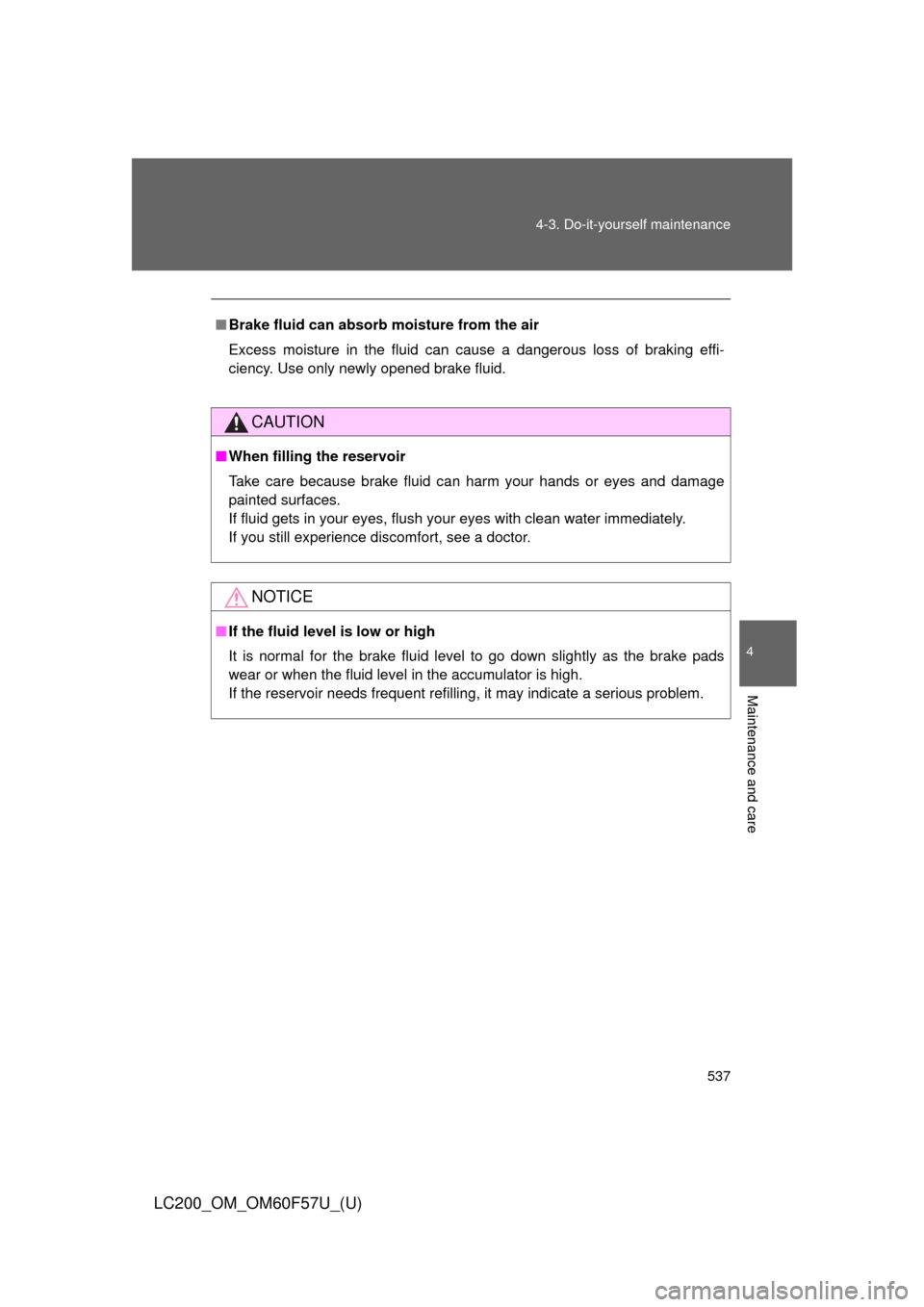
537 4-3. Do-it-yourself maintenance
4
Maintenance and care
LC200_OM_OM60F57U_(U)
■Brake fluid can absorb moisture from the air
Excess moisture in the fluid can cause a dangerous loss of braking effi-
ciency. Use only newly opened brake fluid.
CAUTION
■When filling the reservoir
Take care because brake fluid can harm your hands or eyes and damage
painted surfaces.
If fluid gets in your eyes, flush your eyes with clean water immediately.
If you still experience discomfort, see a doctor.
NOTICE
■If the fluid level is low or high
It is normal for the brake fluid level to go down slightly as the brake pads
wear or when the fluid level in the accumulator is high.
If the reservoir needs frequent refilling, it may indicate a serious problem.
Page 571 of 720
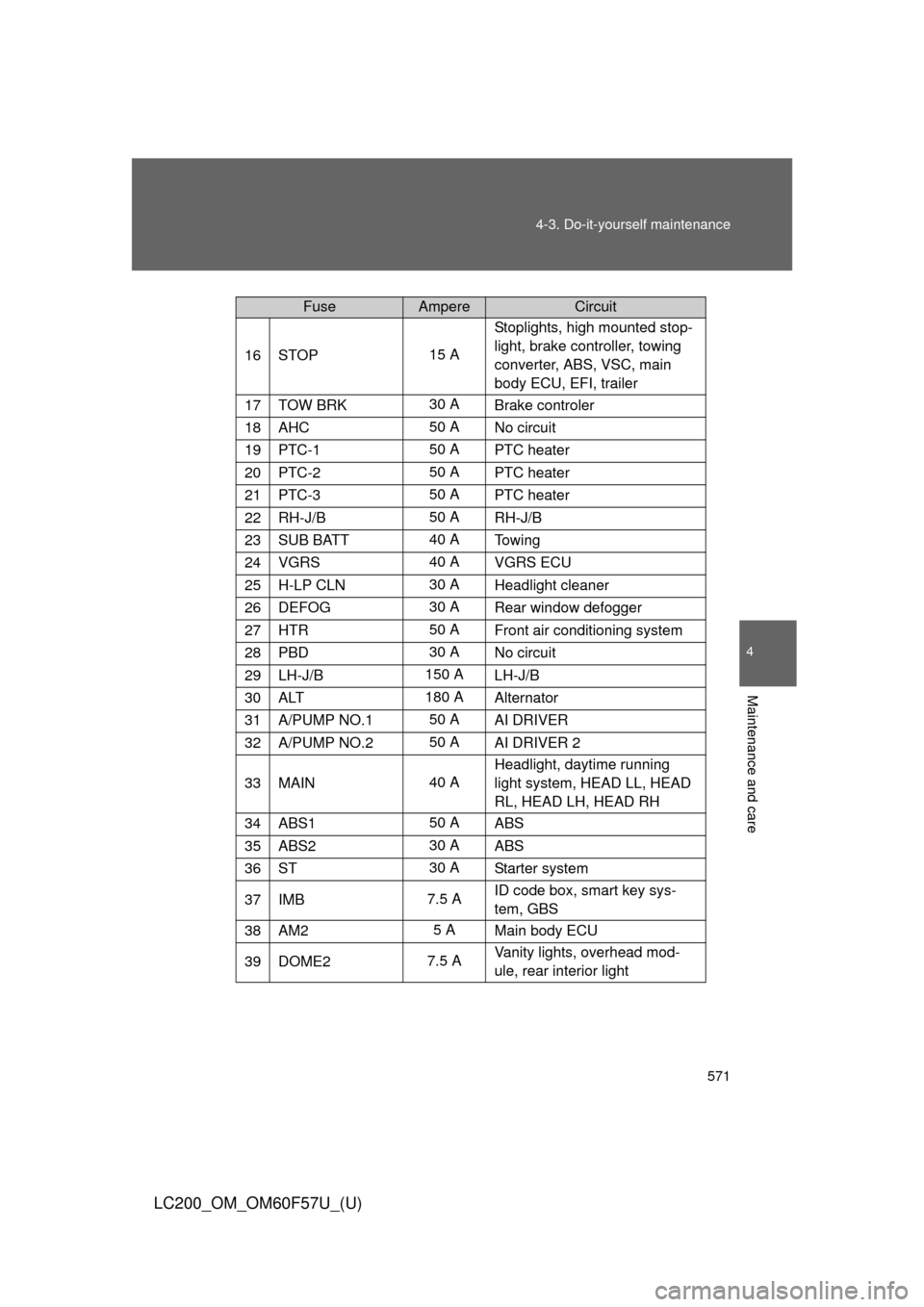
571 4-3. Do-it-yourself maintenance
4
Maintenance and care
LC200_OM_OM60F57U_(U)
16STOP15 AStoplights, high mounted stop-
light, brake controller, towing
converter, ABS, VSC, main
body ECU, EFI, trailer
17TOW BRK30 A
Brake controler
18AHC50 A
No circuit
19PTC-150 A
PTC heater
20PTC-250 A
PTC heater
21PTC-350 A
PTC heater
22RH-J/B50 A
RH-J/B
23SUB BATT40 A
To w i n g
24VGRS40 A
VGRS ECU
25H-LP CLN30 A
Headlight cleaner
26DEFOG30 A
Rear window defogger
27HTR50 A
Front air conditioning system
28PBD30 A
No circuit
29LH-J/B150 A
LH-J/B
30ALT180 A
Alternator
31A/PUMP NO.150 A
AI DRIVER
32A/PUMP NO.250 A
AI DRIVER 2
33MAIN40 AHeadlight, daytime running
light system, HEAD LL, HEAD
RL, HEAD LH, HEAD RH
34ABS150 A
ABS
35ABS230 A
ABS
36ST30 A
Starter system
37IMB7.5 AID code box, smart key sys-
tem, GBS
38AM25 A
Main body ECU
39DOME27.5 AVanity lights, overhead mod-
ule, rear interior light
FuseAmpereCircuit
Page 574 of 720
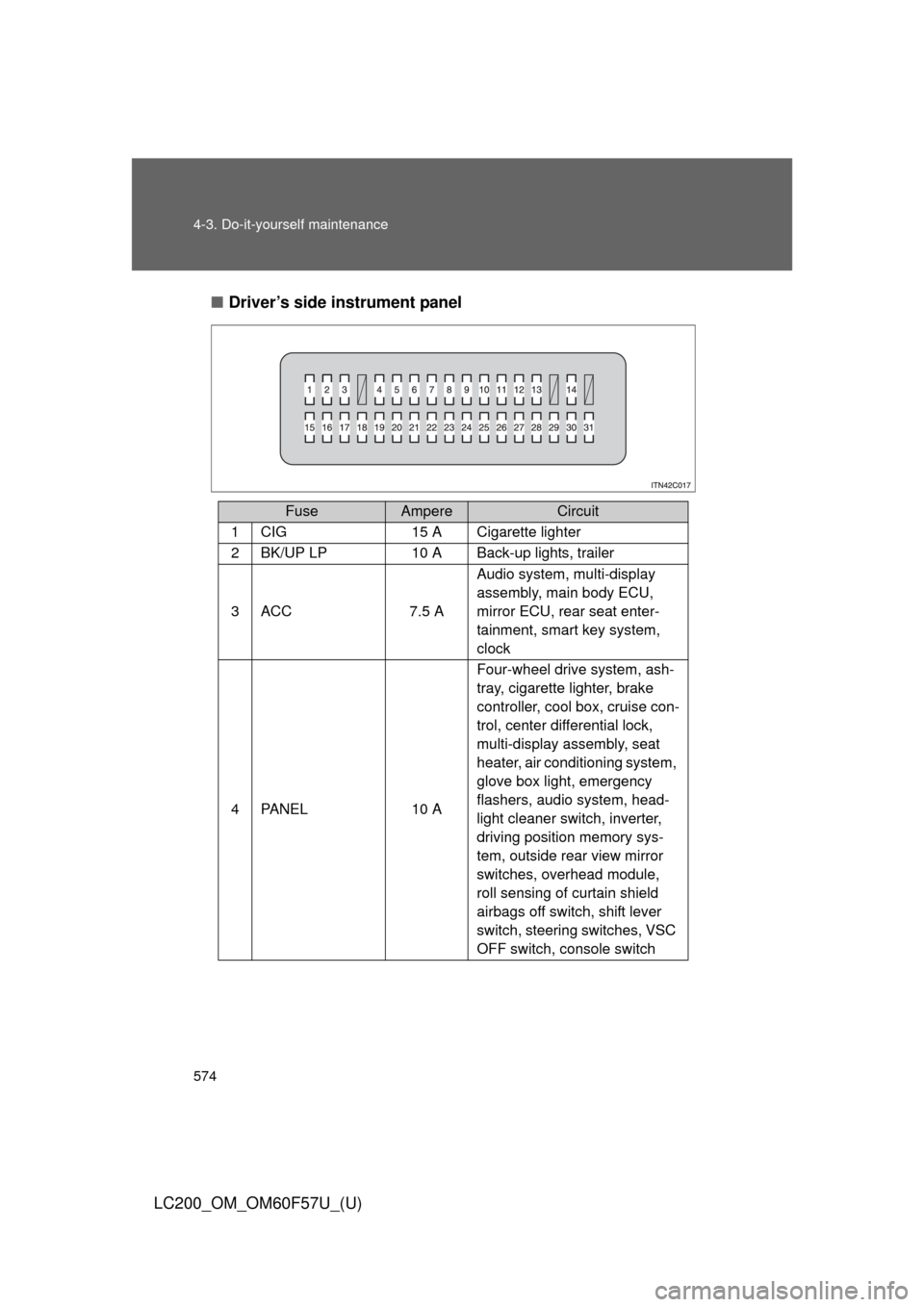
574 4-3. Do-it-yourself maintenance
LC200_OM_OM60F57U_(U)■Driver’s side instrument panel
FuseAmpereCircuit
1CIG15 A Cigarette lighter
2BK/UP LP10 A Back-up lights, trailer
3ACC7.5 AAudio system, multi-display
assembly, main body ECU,
mirror ECU, rear seat enter-
tainment, smart key system,
clock
4PA N E L10 AFour-wheel drive system, ash-
tray, cigarette lighter, brake
controller, cool box, cruise con-
trol, center differential lock,
multi-display assembly, seat
heater, air conditioning system,
glove box light, emergency
flashers, audio system, head-
light cleaner switch, inverter,
driving position memory sys-
tem, outside rear view mirror
switches, overhead module,
roll sensing of curtain shield
airbags off switch, shift lever
switch, steering switches, VSC
OFF switch, console switch
Page 606 of 720
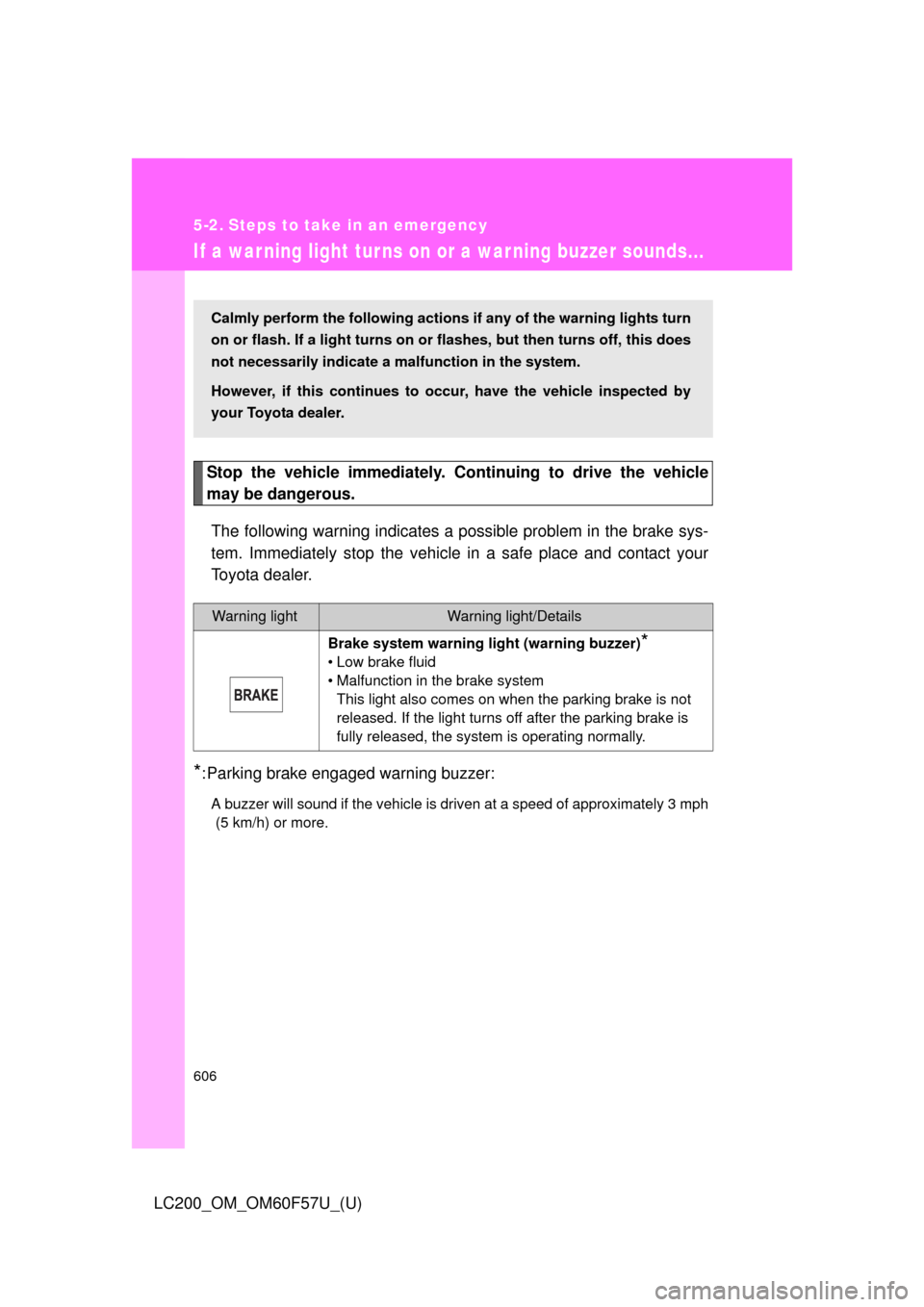
606
LC200_OM_OM60F57U_(U)
5-2. Steps to take in an emergency
If a war ning light tur ns on or a war ning buzzer sounds...
Stop the vehicle immediately. Continuing to drive the vehicle
may be dangerous.
The following warning indicates a possible problem in the brake sys-
tem. Immediately stop the vehicle in a safe place and contact your
Toyota dealer.
*:Parking brake engaged warning buzzer:
A buzzer will sound if the vehicle is driven at a speed of approximately 3 mph
(5 km/h) or more.
Warning lightWarning light/Details
Brake system warning light (warning buzzer)
*
• Low brake fluid
• Malfunction in the brake system
This light also comes on when the parking brake is not
released. If the light turns off after the parking brake is
fully released, the system is operating normally.
Calmly perform the following actions if any of the warning lights turn
on or flash. If a light turns on or flashes, but then turns off, this does
not necessarily indicate a malfunction in the system.
However, if this continues to occur, have the vehicle inspected by
your Toyota dealer.
Page 608 of 720
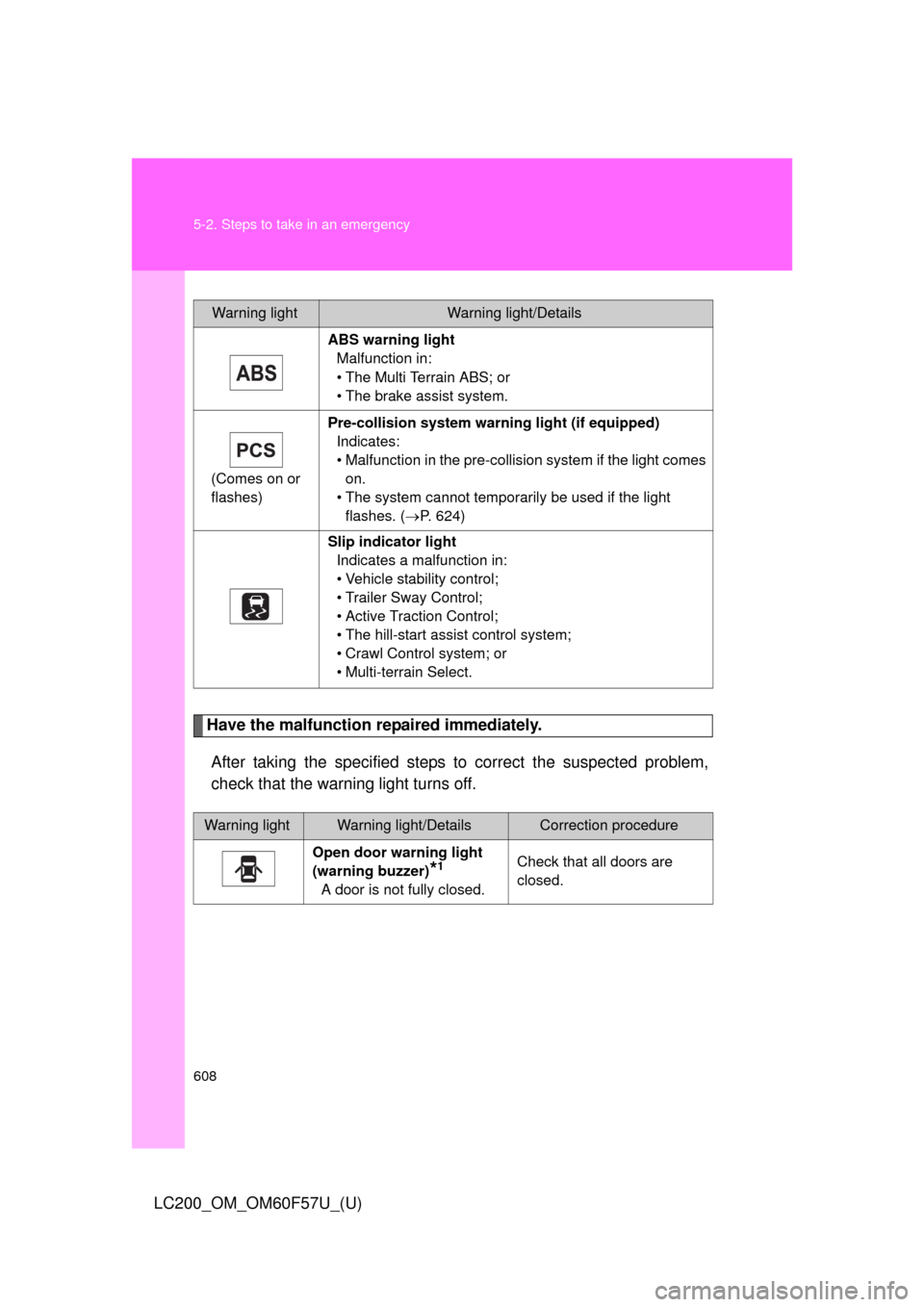
608 5-2. Steps to take in an emergency
LC200_OM_OM60F57U_(U)
Have the malfunction repaired immediately.
After taking the specified steps to correct the suspected problem,
check that the warning light turns off.
Warning lightWarning light/Details
ABS warning light
Malfunction in:
• The Multi Terrain ABS; or
• The brake assist system.
(Comes on or
flashes)Pre-collision system warning light (if equipped)
Indicates:
• Malfunction in the pre-collision system if the light comes
on.
• The system cannot temporarily be used if the light
flashes. (P. 624)
Slip indicator light
Indicates a malfunction in:
• Vehicle stability control;
• Trailer Sway Control;
• Active Traction Control;
• The hill-start assist control system;
• Crawl Control system; or
• Multi-terrain Select.
Warning lightWarning light/DetailsCorrection procedure
Open door warning light
(warning buzzer)
*1
A door is not fully closed.Check that all doors are
closed.
Page 611 of 720
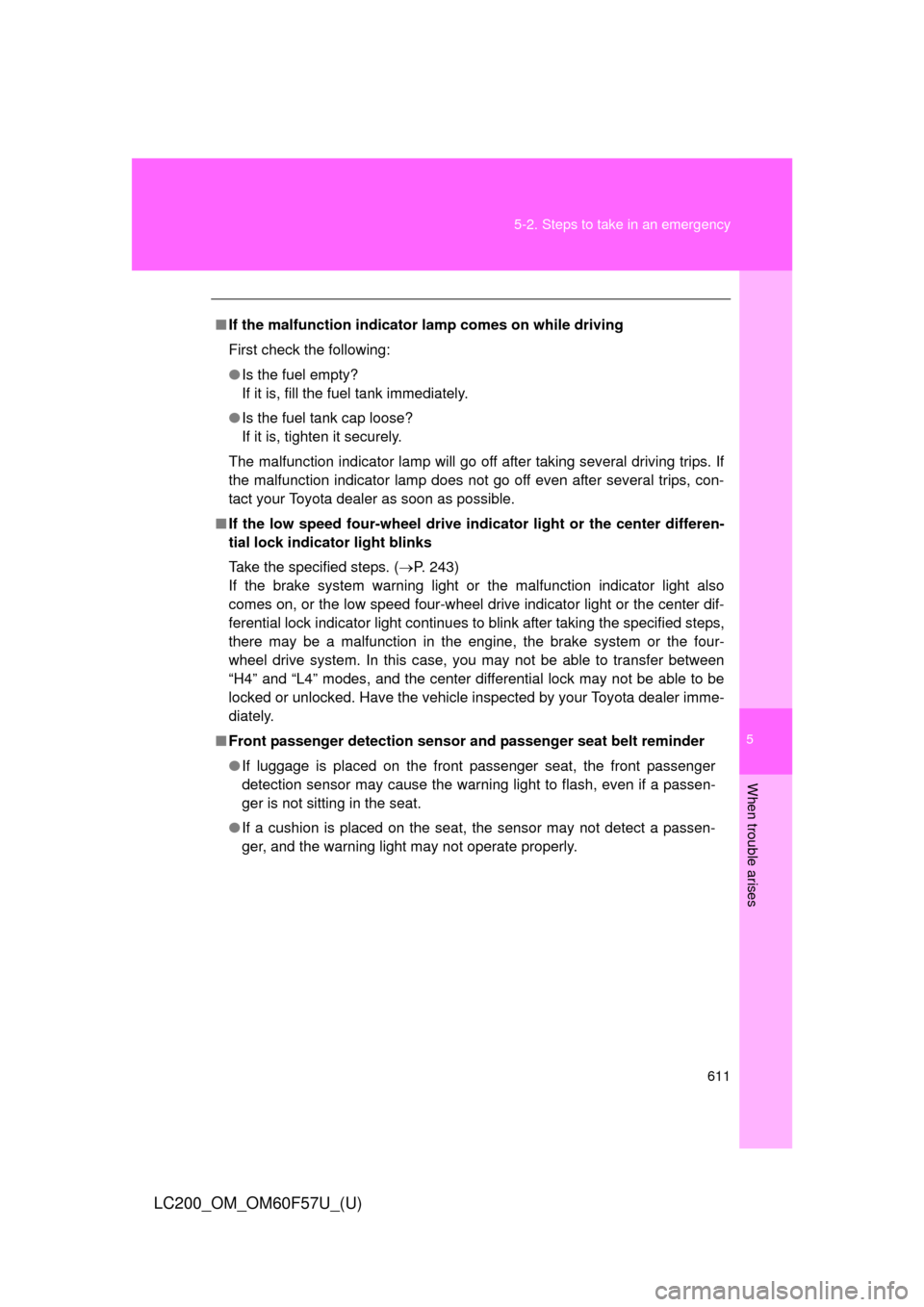
5
When trouble arises
611 5-2. Steps to take in an emergency
LC200_OM_OM60F57U_(U)
■If the malfunction indicator lamp comes on while driving
First check the following:
●Is the fuel empty?
If it is, fill the fuel tank immediately.
●Is the fuel tank cap loose?
If it is, tighten it securely.
The malfunction indicator lamp will go off after taking several driving trips. If
the malfunction indicator lamp does not go off even after several trips, con-
tact your Toyota dealer as soon as possible.
■If the low speed four-wheel drive indicator light or the center differen-
tial lock indicator light blinks
Take the specified steps. (P. 243)
If the brake system warning light or the malfunction indicator light also
comes on, or the low speed four-wheel drive indicator light or the center dif-
ferential lock indicator light continues to blink after taking the specified steps,
there may be a malfunction in the engine, the brake system or the four-
wheel drive system. In this case, you may not be able to transfer between
“H4” and “L4” modes, and the center differential lock may not be able to be
locked or unlocked. Have the vehicle inspected by your Toyota dealer imme-
diately.
■Front passenger detection sensor and passenger seat belt reminder
●If luggage is placed on the front passenger seat, the front passenger
detection sensor may cause the warning light to flash, even if a passen-
ger is not sitting in the seat.
●If a cushion is placed on the seat, the sensor may not detect a passen-
ger, and the warning light may not operate properly.
Page 614 of 720
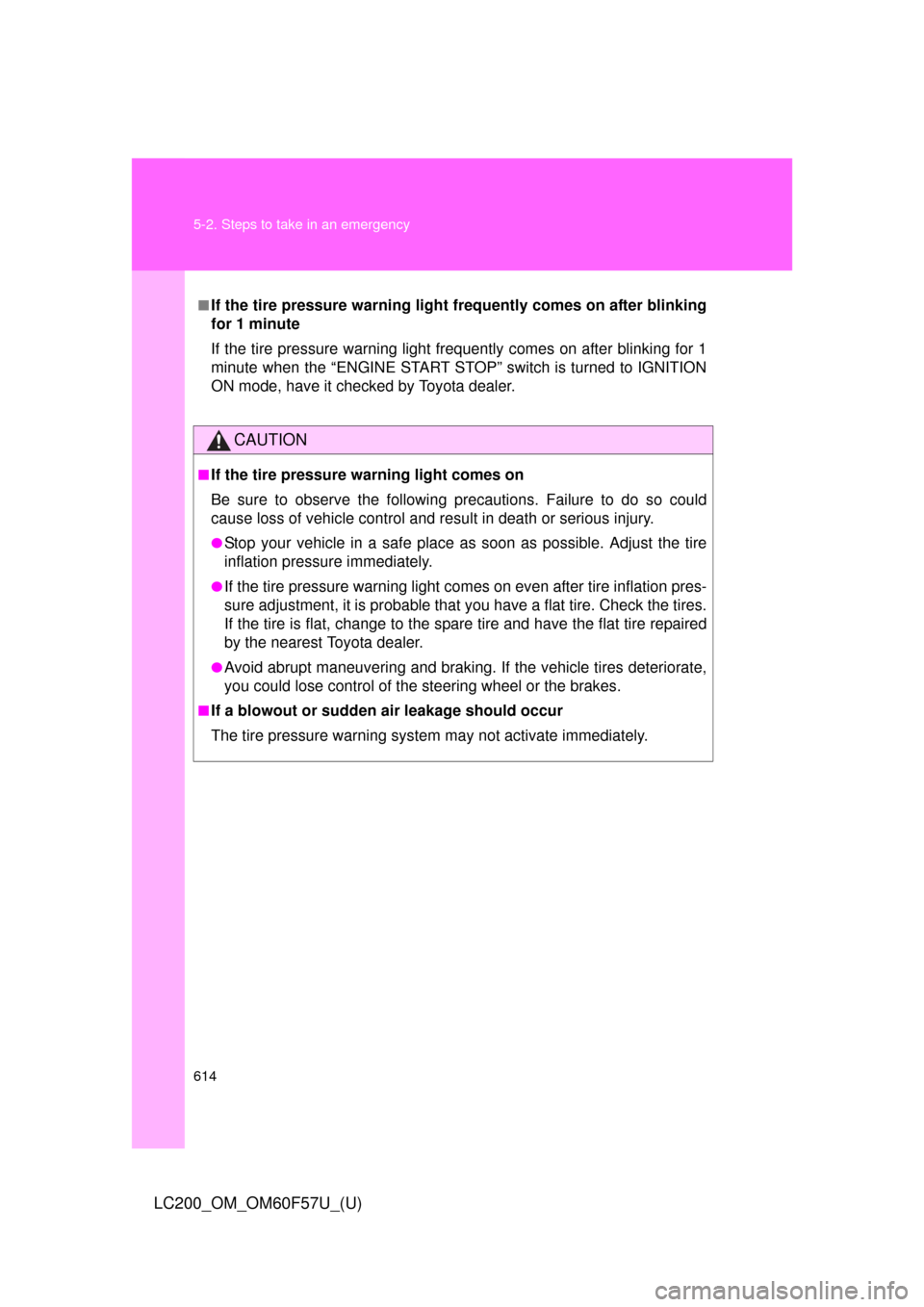
614 5-2. Steps to take in an emergency
LC200_OM_OM60F57U_(U)
■If the tire pressure warning light frequently comes on after blinking
for 1 minute
If the tire pressure warning light frequently comes on after blinking for 1
minute when the “ENGINE START STOP” switch is turned to IGNITION
ON mode, have it checked by Toyota dealer.
CAUTION
■If the tire pressure warning light comes on
Be sure to observe the following precautions. Failure to do so could
cause loss of vehicle control and result in death or serious injury.
●Stop your vehicle in a safe place as soon as possible. Adjust the tire
inflation pressure immediately.
●If the tire pressure warning light comes on even after tire inflation pres-
sure adjustment, it is probable that you have a flat tire. Check the tires.
If the tire is flat, change to the spare tire and have the flat tire repaired
by the nearest Toyota dealer.
●Avoid abrupt maneuvering and braking. If the vehicle tires deteriorate,
you could lose control of the steering wheel or the brakes.
■If a blowout or sudden air leakage should occur
The tire pressure warning system may not activate immediately.
Page 621 of 720
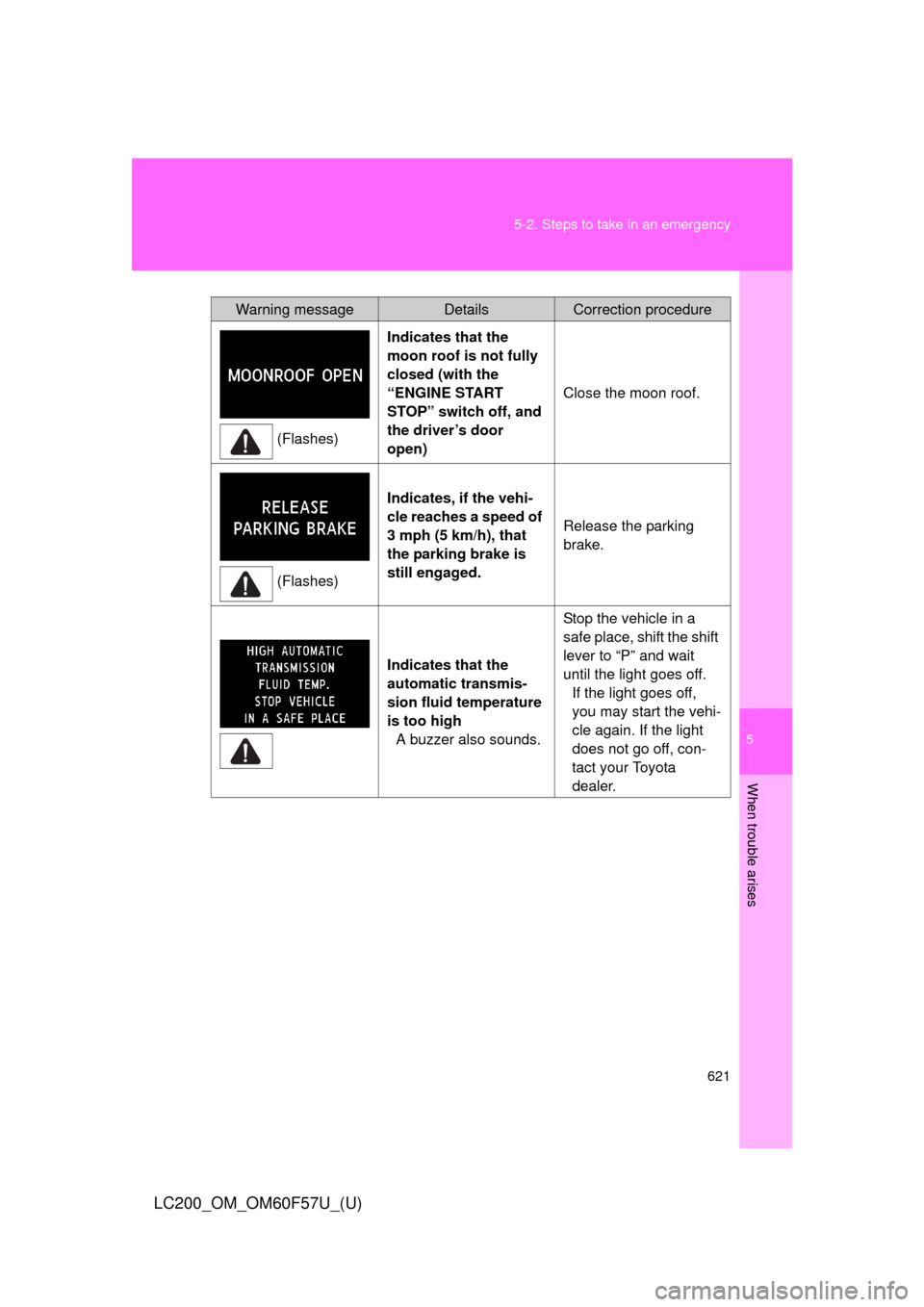
5
When trouble arises
621 5-2. Steps to take in an emergency
LC200_OM_OM60F57U_(U)
(Flashes)Indicates that the
moon roof is not fully
closed (with the
“ENGINE START
STOP” switch off, and
the driver’s door
open)Close the moon roof.
(Flashes)Indicates, if the vehi-
cle reaches a speed of
3 mph (5 km/h), that
the parking brake is
still engaged.Release the parking
brake.
Indicates that the
automatic transmis-
sion fluid temperature
is too high
A buzzer also sounds.Stop the vehicle in a
safe place, shift the shift
lever to “P” and wait
until the light goes off.
If the light goes off,
you may start the vehi-
cle again. If the light
does not go off, con-
tact your Toyota
dealer.
Warning messageDetailsCorrection procedure
Page 648 of 720
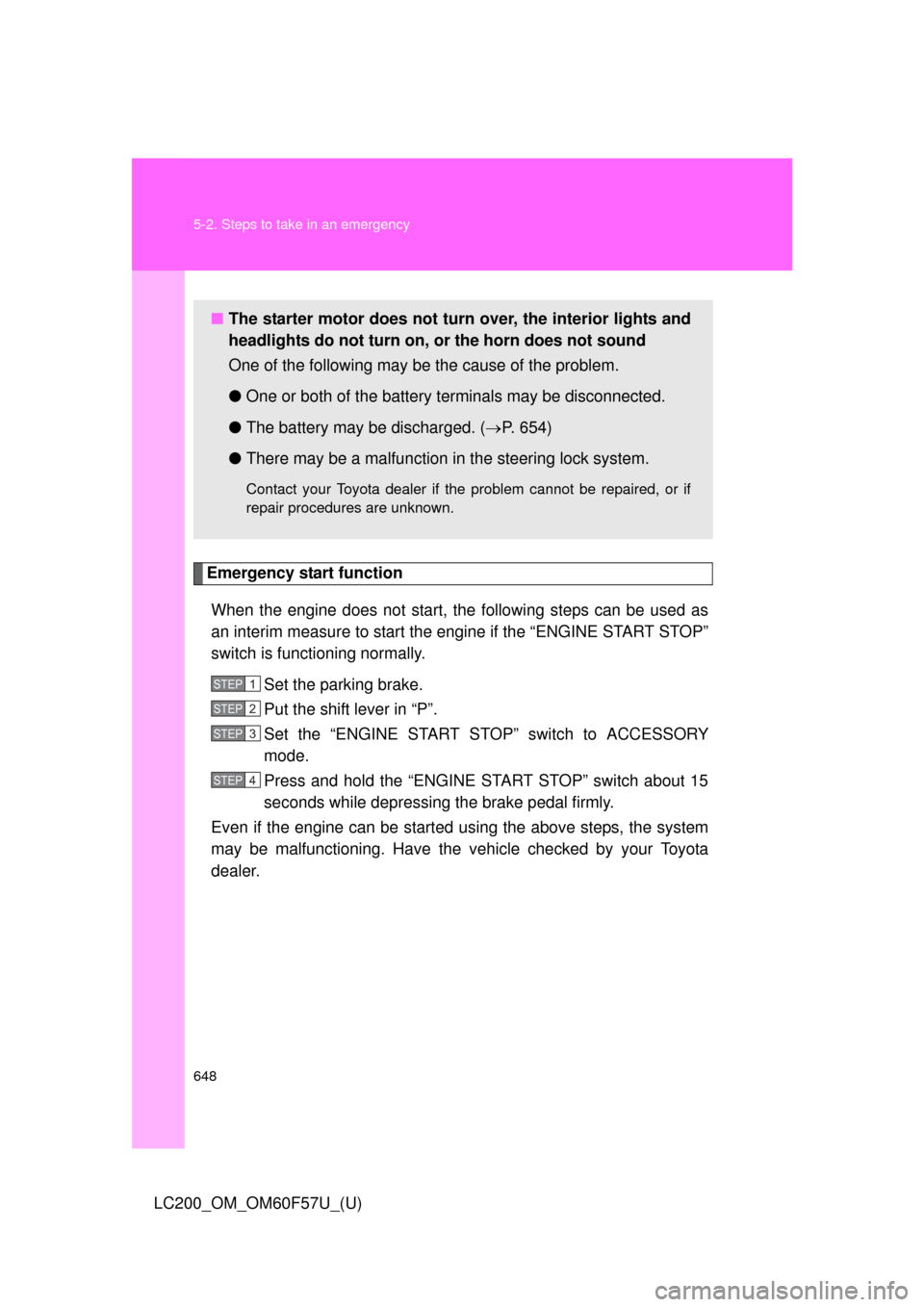
648 5-2. Steps to take in an emergency
LC200_OM_OM60F57U_(U)
Emergency start function
When the engine does not start, the following steps can be used as
an interim measure to start the engine if the “ENGINE START STOP”
switch is functioning normally.
Set the parking brake.
Put the shift lever in “P”.
Set the “ENGINE START STOP” switch to ACCESSORY
mode.
Press and hold the “ENGINE START STOP” switch about 15
seconds while depressing the brake pedal firmly.
Even if the engine can be started using the above steps, the system
may be malfunctioning. Have the vehicle checked by your Toyota
dealer.
■The starter motor does not turn over, the interior lights and
headlights do not turn on, or the horn does not sound
One of the following may be the cause of the problem.
●One or both of the battery terminals may be disconnected.
●The battery may be discharged. (P. 654)
●There may be a malfunction in the steering lock system.
Contact your Toyota dealer if the problem cannot be repaired, or if
repair procedures are unknown.
STEP1
STEP2
STEP3
STEP4